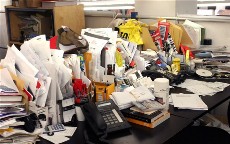
Look around your desk and see how it is organized? How many items do you have lying around and taking up precious desk real estate? If you are like most people your office desk is cluttered with items that you rarely use. Over time the desk has become a garbage dump of papers, staplers, pens, scissor, paper clips and so on. This is pity because research shows that the cluttered desk can reduce the productivity of the person sitting on it. A desk that is neatly organized can help find items quickly and improve your output significantly. The P-L-A-C-E method we described below can help you achieve the goal of organizing your desk for maximum productivity.
Purge
Get rid of all unnecessary items. Many people keep plants, pens, pencils, scissors, paper clips, and a bunch of other junk right out in the open. But you don’t need all these stuff all the time. If you never use a pen, for example, remove it. Same goes for other useless items such as old sticky notes, half-bent paper clips, a busted stapler, and odd trinkets that you collected over the years.
These things take up space. More than that, they are a constant distraction. They are contributing to the background “noise” in your workspace. These things just represent more “stuff” that you have to shuffle around to get at things you actually need.
Like with like
If you have an L-shaped desk at your office, take advantage of it. Sort like items together. For example, if you have more than one stapler that you use, or have a sorting system that requires glue, a stapler, and envelopes and a stamp, sort all of these items together.
Access needs sorting
When is the last time you used that pencil lying in the corner of the desk? If you don’t use something regularly, don’t keep it within easy reach. Store it on a shelf, in a cupboard, hide it in a drawer, or find some other way to place it out of sight.
This is called “organizing according to your access needs.” If you don’t use it very often, or don’t need to access it frequently, it doesn’t need to be within arm’s length. The less you use something, the farther away you can store it. Some items actually belong in the storage closet – off your desk entirely.
Contain loose items
Pens, pencils, markers, staple refills, paper clips, memos, scissors, reading glasses, hand sanitizes – all these items tend to “float” around your desk. Organize them by containing them. For example, pens can be put in a pen holder (i.e. a small jar or mug). Markers can be stored the same way. Scissors can be placed flat in a drawer, and paper clips can be placed in a small container dish (i.e. a magnetic dish that keeps them from scattering). Stapler refills can often be put back into the box they came in or stored in a small magnetic dish.
A well organized desk acts as a catalyst for productivity. By following these guidelines you can ensure that your desk remains free of clutter helping you get more done in less time.
What is your experience? How does your desk look right now? Let us know in the comments below.
Albert Stayton has been an office manager for several years. He often contributes to business blogs, writing about office optimization. Visit the www.ifurn.com website for L-Shape and other desk ideas.






